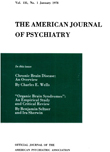THE MYTH OF THE PSYCHOPATHIC PERSONALITY
Abstract
1. The concept of psychopathic personality is at present in a transitional state. While most clinical workers in the field still move at the superficial descriptive level, some attempt for delimitation is already being made, though it is still mainly at the descriptive level; while a few, as yet in great minority, are attempting to interpret the reaction in terms of underlying dynamics, emphasizing motivation rather than behavior.
2. One of the greatest difficulties in the whole situation is that the majority of writers do not offer adequately worked up case material, which therefore precludes a dynamic formulation.
3. Some workers appear to get away from the previously held concept that the condition is hereditary and constitutional. Instead, the emphasis on psychogenesis appears to be gaining ground. Unfortunately, this remains for the most a statement without casuistic material to support it.
4. Equally, the grouping is being more and more narrowed, and some workers exclude from the consideration of psychopathy the psychotic reaction types, even if and when they have an undoubted antisocial and delinquent character. But the great variety of hysterical and neurotic conditions are still grouped with psychopathy, when these conditions include some definite anti-social and delinquent behavior.
5. On the basis of carefully studied material and due consideration being given to dynamics of the situation, the following reorientation is offered, namely:
a. That what is commonly diagnosed now as psychopathic personality should be divided into two main groups: the symptomatic or secondary psychopathy, and primary, essential, or idiopathic psychopathy.
b. Under the heading of symptomatic or secondary psychopathy are to be included those cases of psychoses and neuroses that have a strong antisocial or delinquent aspect, and the case in question should be put into its proper clinical heading (psychosis or neurosis as the case may be). Thus a case may be diagnosed as manic-depressive psychosis, hypomania, antisocial delinquent trends. The term psychopathic, therefore, may be completely eliminated from this group of cases as being only confusing.
c. The clinical worker who puts emphasis on motivation rather than behavior will have no difficulty uncovering pointed psychogenesis in all these cases. By the same token they are amenable to psychotherapeutic treatment and therefore offer a far more hopeful outlook than is currently given to psychopathic cases.
d. In the remaining small group are to be put those individuals who do not fit at all into any of the cardinal reaction types; above all they seem to lack any psychogenetic aspect even when definite effort has been made to elicit the same. They form a disease of its own designated as anethopathy, a specific mental disease, characterized by a special personality organization having in particular a virtual absence of any redeeming social reaction: conscience, guilt, binding and generous emotions, etc., while purely egoistic, uninhibited instinctive trends are predominant. They are as close to the constitutional as can be found. The term psychopathic personality may be omitted from these cases too.
6. With the larger number of psychopathic personality cases being properly put under the respective headings of the cardinal reaction types, and the balance being put in a new group designated anethopathy, nothing remains of the original concept of psychopathic personality, for which reason it should be completely deleted from psychiatric nosology. The term may be left entirely for lay use.
7. A number of cases have been cited demonstrating the various types of psychopathic personality with emphasis on the dynamics of the situation.
Access content
To read the fulltext, please use one of the options below to sign in or purchase access.- Personal login
- Institutional Login
- Sign in via OpenAthens
- Register for access
-
Please login/register if you wish to pair your device and check access availability.
Not a subscriber?
PsychiatryOnline subscription options offer access to the DSM-5 library, books, journals, CME, and patient resources. This all-in-one virtual library provides psychiatrists and mental health professionals with key resources for diagnosis, treatment, research, and professional development.
Need more help? PsychiatryOnline Customer Service may be reached by emailing [email protected] or by calling 800-368-5777 (in the U.S.) or 703-907-7322 (outside the U.S.).



